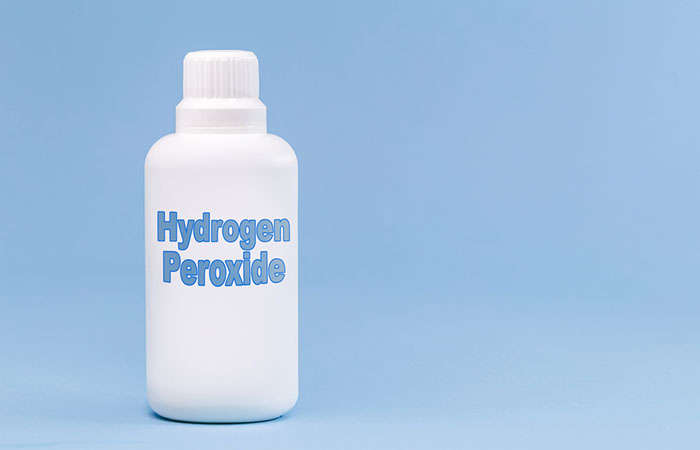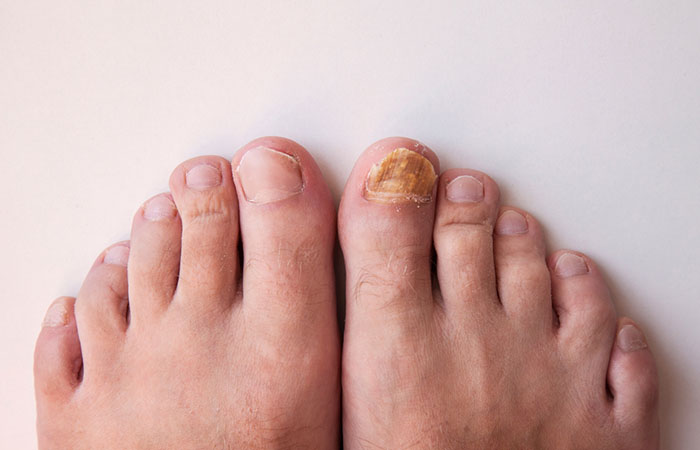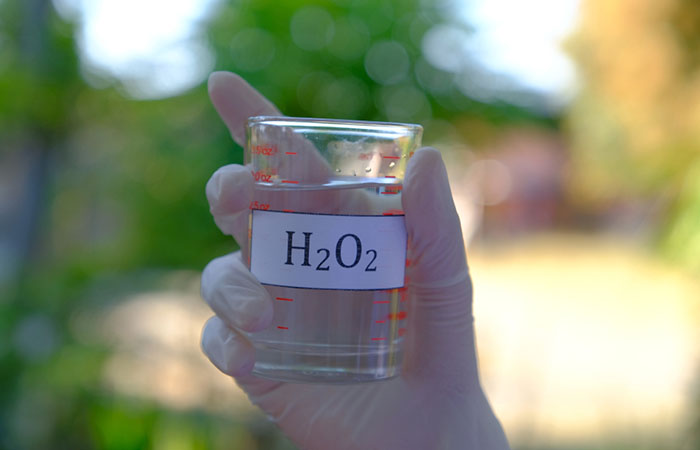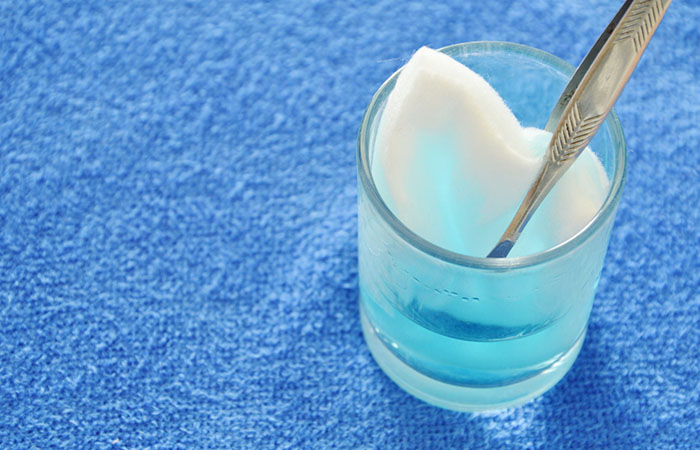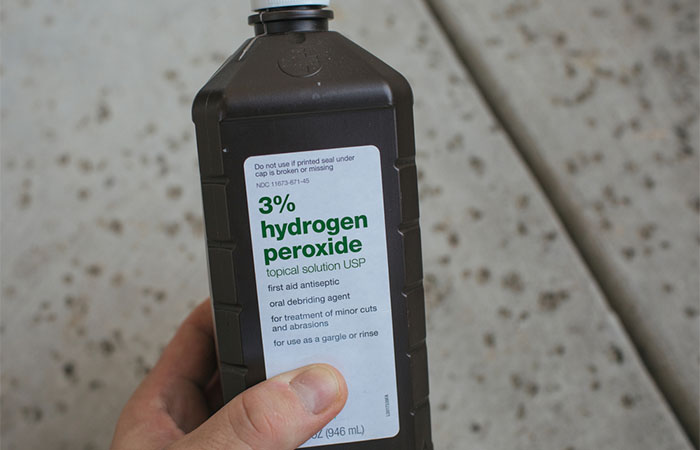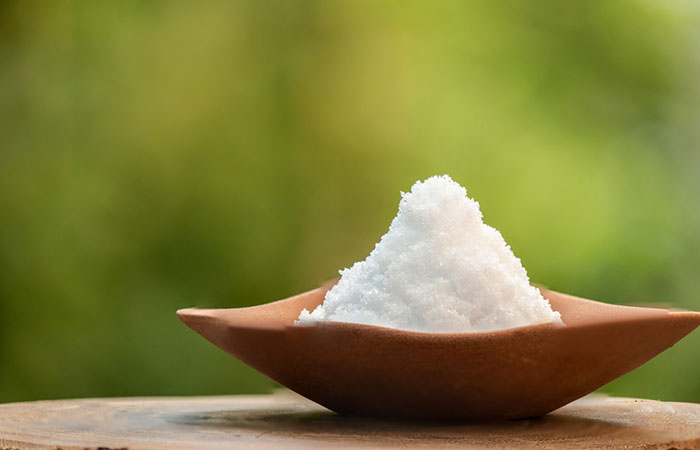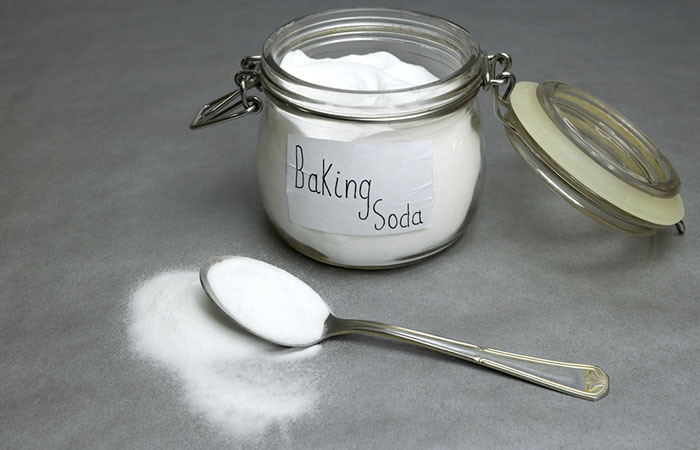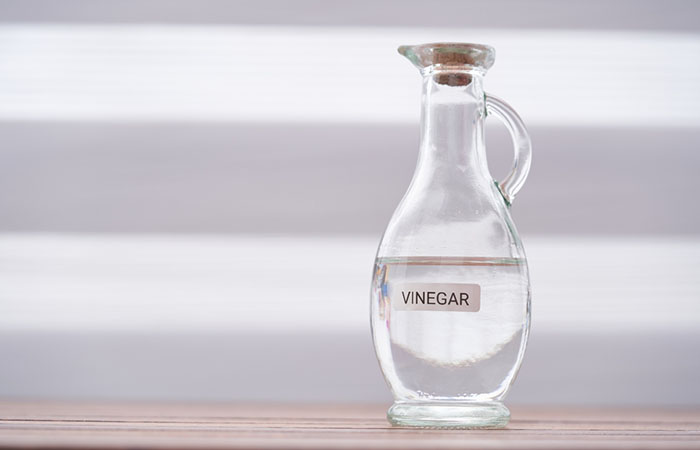What Is Hydrogen Peroxide?
Hydrogen peroxide is a chemical compound valued for its disinfectant, antiseptic, and bleaching properties. It effectively eliminates bacteria, viruses, and fungi, making it a popular choice for household use. Available in various concentrations, it is commonly employed to cleanse wounds and sanitize surfaces. Its oxidizing nature breaks down and neutralizes harmful microorganisms, ensuring effective cleaning and sterilization in diverse settings. Hydrogen peroxide is a common remedy for treating issues like toenail fungus. But before we get into how it works as an antimicrobial solution, let’s uncover the causes of toenail fungus to understand why such treatments are necessary.
Causes Of Toenail Fungus
Toenail fungus, also known as onychomycosis, can be caused by several factors (1) (2) (3) (4):
- Warm And Moist Environment: Toenail fungus can be caused due to prolonged foot exposure to warm, moist environments like humid climates. Warmth and moisture soften the toenail and its skin, facilitating fungal invasion and infection, particularly by dermatophytes.
- Poor Foot Hygiene: Neglecting foot hygiene may contribute to toenail fungus. Not drying your feet properly after bathing or wearing damp socks and shoes for extended periods may create an ideal environment for fungi to grow and infect the toenails.
- Injuries To The Nail Or Skin: Any trauma or injury to the toenail or surrounding skin may create openings for fungi to enter and cause an infection. This can include minor injuries like stubbing your toe, getting a pedicure with tools that haven’t been properly sterilized, or wearing tight-fitting shoes that cause repeated trauma to the nails.
- Weakened Immune System: People with weakened immune systems are more susceptible to toenail fungus infections. A compromised immune system reduces the body’s ability to fight off fungal infections effectively.
- Age And Genetics: As we age, our nails tend to become more brittle and dry, making them more susceptible to fungal infections. Genetics also plays a role, as some people are genetically predisposed to fungal infections, making them more likely to develop toenail fungus even without other risk factors.
- Walking Barefoot In Public Places: Walking barefoot in places like gyms, pools, or public showers also increases the risk of coming into contact with fungi that cause toenail infections.
- Yeasts And Molds: Certain yeasts and molds may cause toenail fungus infections, similar to fungi. These tiny organisms penetrate the nail via openings in the skin caused by cracks or breaks. These were some of the major causes of toenail fungus. It is important to identify the symptoms of this infection to be able to properly treat the condition. Read through the symptoms in the section below.
Toenail Fungus Symptoms
The following symptoms of toenail fungus may help you recognize its cause and seek proper treatment (1) (3):
Thickened nails that may appear crumbly or brittle. Discoloration, often yellow or brownish, of the affected nail. Distorted nail shape, such as curling or unusual growth patterns. Foul odor emanating from the infected toenail. Pain or discomfort in the affected toe, particularly when wearing shoes or walking.
Now that you know the causes and the symptoms to look for, let’s determine whether hydrogen peroxide is effective for treating toenail fungus.
Is Hydrogen Peroxide Good For Toenail Fungus?
There is some debate among doctors about how well hydrogen peroxide works for toenail fungus. It is widely used as an antiseptic, disinfectant, oxidizer, and bleaching agent, and has strong antifungal properties (5) (6). Many people use it as a home remedy for nail fungus, believing it to be effective despite limited scientific research. However, high concentrations of hydrogen peroxide may harm human cells, causing skin damage, redness, itching, swelling, blistering, stinging, and rashes (7) (8). Are you curious about hydrogen peroxide’s battle against fungal infections? Learn more in the section below!
How Does Hydrogen Peroxide Fight Fungal Infections?
Hydrogen peroxide combats fungal infections by releasing oxygen, creating an inhospitable environment (9). When applied to the affected areas, it breaks down into water and oxygen, generating bubbles that clean and disrupt fungal cells. It attacks fungal cell walls, weakening and killing them. Also its antibacterial properties prevent secondary infections, aiding natural healing. These known properties make using hydrogen peroxide for nail fungus a common practice. However, its effectiveness can be limited as it may not penetrate deep enough into the nail bed where the infection persists. There are a few easy ways to use hydrogen peroxide for toenail fungus. Read through the next section to learn more.
How To Use Hydrogen Peroxide For Toenail Fungus?
Using a hydrogen peroxide treatment to treat toenail fungus is simple. All you need to do is follow the guide below:
1. Soak Your Feet In Hydrogen Peroxide
What You Will Need
Hydrogen peroxide (3% solution) Water (enough to soak your feet) A tub A towel/tissues
Duration 15-30 minutes Method How Often? Repeat twice daily until the fungus is gone. This may take several weeks to a few months. Why This Works Hydrogen peroxide has antifungal properties that may kill the fungus and clean the infected area, preventing further growth and aiding healing. This treatment may increase oxygen levels and effectively destroy the nail fungus (9). Andrea Jean, a YouTube vlogger, demonstrates the use of hydrogen peroxide on her feet in a video. She says, “It Is an all-natural remedy if you have an athlete’s foot. You’re just going to want to shave off, rub off any of that extra dead skin. The hydrogen peroxide helps loosen it and kill any bacteria (i).”
2. Epsom Salt And Hydrogen Peroxide For Toenail Fungus
What You Will Need
2 tablespoons of Epsom salt 1 cup of hydrogen peroxide Warm water (enough to soak your feet) A tub A towel
Duration 15-20 minutes Method How Often? Repeat this process once daily until the fungus is gone. Why This Works Epsom salt may help reduce inflammation and soften the skin, making it easier for the hydrogen peroxide to penetrate through (10) (11).
3. Baking Soda And Hydrogen Peroxide For Toenail Fungus
What You Will Need
2 tablespoons of baking soda 1 cup of 3% hydrogen peroxide Warm water (enough to soak your feet) A tub A towel
Duration 15-20 minutes Method How Often? Repeat this process once daily until the fungus is gone. Why This Works Baking soda may stop the fungus from growing because it has antifungal qualities. According to a study, sodium bicarbonate showed promising antifungal effects against a variety of fungal strains causing skin and nail infections in both laboratory and clinical settings (12).
4. Vinegar And Hydrogen Peroxide For Toenail Fungus
What You Will Need
1 cup of white vinegar 1 cup of hydrogen peroxide Warm water (enough to soak your feet) A tub A towel
Duration 15-20 minutes Method How Often? Repeat this process once daily until the fungus is gone. Why This Works Vinegar has antimicrobial and antioxidant properties (13). These properties make it effective in combating bacterial and fungal infections, including toenail fungus. You can also try other popular natural remedies if the above-listed methods do not work for you. Many people also recommend using tea tree oil for toenail fungus, for its natural ability to combat fungal infections and promote healthy nails. Garlic, aloe vera, and even mouthwash solutions are said to be effective as per anecdotal evidence. Note: If your symptoms don’t get better but rather worse and spread on your foot, see a doctor immediately. If you notice more dryness and cracking, reduce soaking to a few times a week instead of daily. If you plan to use hydrogen peroxide on your nails, you need to understand the precautions to be taken beforehand!
Precautions For Hydrogen Peroxide Use
Here are some important precautions to consider when using hydrogen peroxide to ensure safe and effective application. Here are some additional tips and suggestions in the following section to help you prevent possible toenail fungus. Continue scrolling.
Preventing Tips For Toenail Fungus
Below are some tips that will surely help you prevent this condition: How long does it take for hydrogen peroxide to kill toenail fungus? Regular use of hydrogen peroxide may take several weeks or months to effectively kill toenail fungus, depending on how severe the infection is. Why does hydrogen peroxide bubble on nail fungus? When hydrogen peroxide contacts the fungus, you might notice bubbling. Do not worry as this is normal and shows that the solution is breaking down the infection. Does hydrogen peroxide kill fungus on nail clippers? Hydrogen peroxide can help disinfect nail clippers, but it may not effectively kill fungus embedded in the metal. Use antifungal solutions or boiling water to properly sterilize your nail clipper. Is rubbing alcohol or hydrogen peroxide better for toenail fungus? Hydrogen peroxide and rubbing alcohol both kill germs and fungi effectively. You can use rubbing alcohol directly on a clean cloth or soak your feet in a mixture of rubbing alcohol and water for 30 minutes to treat surface infections. Is hydrogen peroxide harmful to nails? When used correctly, hydrogen peroxide is usually safe to apply on your nails. However, high concentrations of hydrogen peroxide can cause severe skin irritation. Discover three effective methods to tackle nail fungus using hydrogen peroxide. This video provides simple, step-by-step instructions for healthier nails. Don’t let nail fungus hold you back. Watch now and restore your nails to their best!
